In the field of embedded computing and network systems, the performance, energy efficiency, and compatibility of processors are often crucial to the success of a design. The MC7447AHX1000NB launched by NXP (formerly Freescale), as an important member of the MPC7447A series, has become an ideal choice for network devices, industrial computing, and other scenarios, thanks to its advanced design based on the PowerPC architecture, a high core frequency of 1000MHz, and rich functional features. This article will comprehensively analyze the core value of this processor from aspects such as technical characteristics, specification parameters, performance advantages, and application scenarios.
MC7447AHX1000NB Overview
The MC7447AHX1000NB is a high-performance RISC microprocessor developed by NXP based on the fourth-generation PowerPC G4 architecture, belonging to the MPC7447A series. Building on the robust foundation of the MPC7447, this processor introduces new features such as Dynamic Frequency Switching (DFS) and temperature diodes, enhancing energy efficiency and thermal management while maintaining full compatibility.
As a pin-compatible upgrade, the MC7447AHX1000NB can directly replace the MPC7447 in existing designs when powered at 1.3V core voltage, eliminating the need for hardware modifications and significantly reducing system upgrade costs and risks. Designed specifically for networking and computing systems, it delivers efficient parallel instruction processing through its superscalar architecture, multi-level caches, and multiple execution units, meeting the demands of high-throughput applications.
MC7447AHX1000NB Attributes
| Product Attribute | Attribute Value |
| Manufacturer | NXP Semiconductors |
| Voltage - I/O | 1.8V, 2.5V |
| USB | - |
| Supplier Device Package | 360-FCCBGA (25x25) |
| Speed | 1.0GHz |
| Series | MPC74xx |
| Security Features | - |
| SATA | - |
| RAM Controllers | - |
| Package / Case | 360-BCBGA, FCCBGA |
| Package | Tray |
| Operating Temperature | 0°C ~ 105°C (TA) |
| Number of Cores / Bus Width | 1 Core, 32-Bit |
| Mounting Type | Surface Mount |
| Graphics Acceleration | No |
| Ethernet | - |
| Display & Interface Controllers | - |
| Core Processor | PowerPC G4 |
| Co-Processors / DSP | Multimedia; SIMD |
| Base Product Number | MC7447 |
| RoHS Status | RoHS non-compliant |
| Moisture Sensitivity Level (MSL) | 1 (Unlimited) |
| REACH Status | REACH Unaffected |
| ECCN | 3A991A2 |
| HTSUS | 8542.31.0001 |
MC7447AHX1000NB Pinout Details
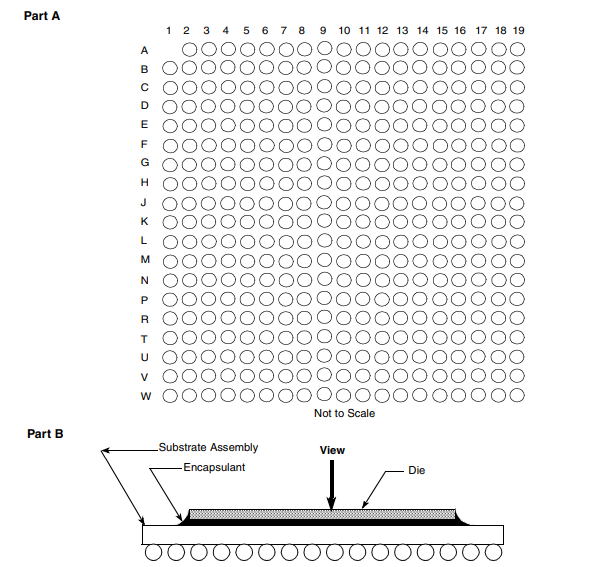
This diagram shows the pin assignments for the MC7447AHX1000NB using the 360 HCTE BGA package. Part A provides a top-view layout of the entire ball grid array, labeled from A to W (rows) and 1 to 19 (columns), helping with clear identification of each pin location. Part B gives a side profile of the package, showing how the internal die sits within the substrate and encapsulant. Together, these views help ensure accurate placement and orientation during board assembly and assist in understanding how the chip connects to the rest of the system.
MC7447AHX1000NB Block Diagram
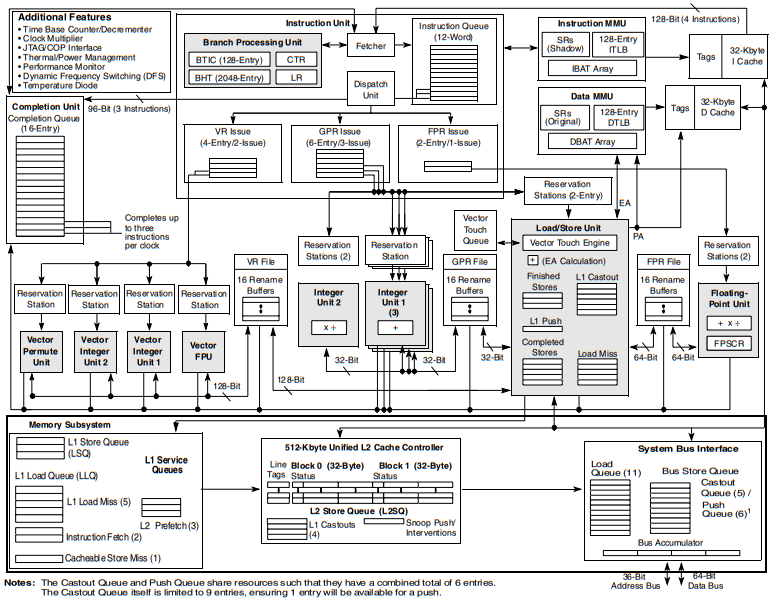
The MC7447AHX1000NB block diagram showcases its PowerPC - based architecture. It has an Instruction Unit with components like the Branch Processing Unit and Instruction Queue. The Completion Unit manages instruction completion. Multiple functional units exist, such as Integer Units, Vector Units, and a Floating - Point Unit. Memory subsystems include caches (L1 and unified L2 cache controller) and queues. The System Bus Interface connects to external systems. Additional features like time - related counters, power management, and debugging interfaces enhance its functionality for embedded computing and network system applications.
MC7447AHX1000NB JTAG Interface Connection
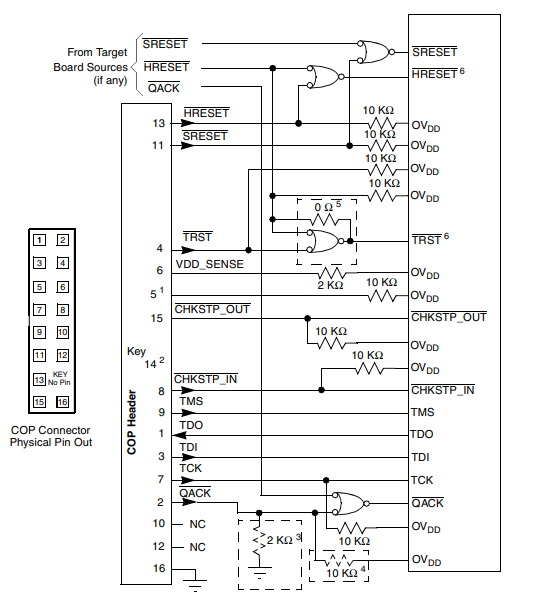
The diagram depicts the JTAG interface connection for the MC7447AHX1000NB, a crucial part for debugging and programming the processor.
Reset Signals: The SRESET and HRESET signals, which can be sourced from the target board if available, are combined through a NOR gate. This ensures that the device is properly reset under various conditions. The QACK signal also interacts with these reset signals, contributing to the overall reset mechanism.
JTAG - Specific Pins: Standard JTAG pins such as TMS (Test Mode Select), TDO (Test Data Output), TDI (Test Data Input), and TCK (Test Clock) are present. TMS controls the state transitions within the JTAG state machine, while TDO and TDI handle data output and input respectively, and TCK provides the clock for JTAG operations. The TRST (Test Reset) pin, which can be toggled to reset the JTAG logic, is also included.
Power - related and Other Signals: The VDD_SENSE pin is used to monitor the power supply. Additionally, CHKSTP_OUT and CHKSTP_IN pins are related to checkpoint functions, allowing for pausing and resuming operations during testing. Pull - up resistors, mainly 10KΩ ones connected to OV<sub>DD</sub>, are used to maintain stable high - level signals when the pins are not actively driven low. Some pins marked as NC (Not Connected) indicate unused connections in this interface setup.
MC7447AHX1000NB Outline Dimensions
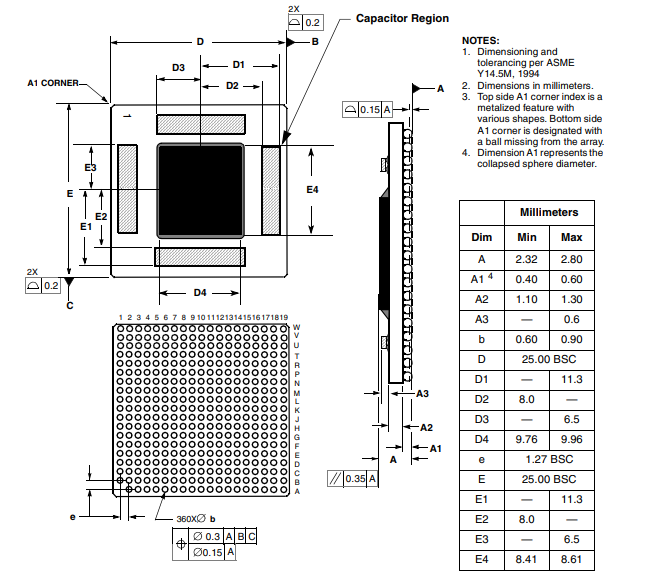
The outline dimensions diagram of the MC7447AHX1000NB provides essential physical specifications. The top - side view shows a rectangular layout with a distinct A1 corner indicator. The dimensions are measured in millimeters as per ASME Y14.5M, 1994 standards. The overall length in the D direction is specified with a basic dimension of 25.00 mm. Key internal dimensions like D1, D2, and D3 help in understanding the layout of internal components. The height - related dimensions such as E, E1, E2, E3, and E4 define the vertical profile of the package. The ball grid array (BGA) layout at the bottom is characterized by a ball diameter specified by dimension b. Additionally, the capacitor region on the top side is marked, indicating areas for component placement. These precise dimensions are crucial for designing the printed circuit board (PCB) to ensure proper integration of the MC7447AHX1000NB.
MC7447AHX1000NB Features
1. Superscalar Architecture and Parallel Execution Capability
The MC7447AHX1000NB features a high-performance superscalar design that enables parallel processing of multiple instructions:
Instruction Flow Handling: It can fetch up to 4 instructions per clock cycle from the L1 instruction cache. The Instruction Queue (IQ) can hold 12 instructions, with up to 16 instructions in various execution stages simultaneously, significantly boosting instruction throughput.
Multiple Execution Units: Comprising 11 independent execution units, including 4 integer units, a 5-stage pipelined Floating-Point Unit (FPU), 4 vector units (supporting AltiVec™ technology), and a 3-stage pipelined Load/Store Unit (LSU). This allows parallel execution of integer, floating-point, and vector operations, completing most instructions within a single cycle.
Branch Prediction: Equipped with a 2048-entry Branch History Table (BHT) and a 128-entry Branch Target Instruction Cache (BTIC), supporting both static and dynamic branch prediction. This drastically reduces branch latency and enhances program execution efficiency.
2. Multi-Level Cache System: The Foundation for Efficient Data Access
The cache system serves as the "accelerator" for processor performance. The MC7447AHX1000NB employs a Harvard architecture-based multi-level cache design:
L1 Cache: Split into 32KB instruction cache and 32KB data cache, both 8-way set-associative with a 32-byte block size and Pseudo-LRU (PLRU) replacement algorithm. The instruction cache delivers 4 instructions per clock cycle, while the data cache supports 4-word/cycle access rates, meeting high-frequency execution demands.
L2 Cache: A unified 512KB cache (shared by instructions and data), 8-way set-associative with a 64-byte line size and fully pipelined design. It transfers 32 bytes of data to the L1 cache per clock cycle, with an access latency of only 9 clock cycles on L1 cache misses, effectively mitigating memory access bottlenecks.
Cache Features: Supports write-back/write-through modes (configurable per page or block), software disable/lock, and maintains hardware coherence via the MESI protocol in the data cache, ensuring data synchronization in multiprocessor systems.
3. Power and Thermal Management: Intelligent Design for Energy Efficiency
To meet the low-power requirements of embedded systems, the MC7447AHX1000NB integrates multiple power and thermal management mechanisms:
Dynamic Frequency Switching (DFS): Allows software-controlled core frequency scaling by half, reducing power consumption during light loads to balance performance and energy efficiency.
Multi-Power Modes: Supports three low-power modes—Nap, Sleep, and Deep Sleep. Deep Sleep mode shuts down the PLL clock source, minimizing standby power consumption (typically 3.2W).
Temperature Monitoring: Built-in temperature diodes provide real-time junction temperature monitoring, enabling proactive thermal management to prevent performance degradation or damage due to overheating.
Voltage Adaptation: Operates at a core voltage of 1.3V±50mV with support for voltage derating, further reducing power consumption when lowering the core frequency to adapt to diverse energy efficiency requirements.
4. Memory Management and Bus Interface: Flexible and Compatible System Connectivity
Memory Management Unit (MMU): Independent instruction and data MMUs supporting 52-bit virtual addresses and 32/36-bit physical addresses. A 128-entry 2-way set-associative TLB handles address translations for 4KB pages, variable-size blocks, and 256MB segments, accommodating complex memory mapping needs.
Bus Protocols: Supports MPX and a subset of the 60x bus protocols, connecting to main memory and other system resources via a 36-bit address bus and 64-bit data bus for high-efficiency data transfer.
Multiprocessor Support: Maintains cache coherence through the MESI protocol and supports "load-reserve/store-conditional" instruction pairs for atomic memory operations, meeting synchronization requirements in multiprocessor systems.
MC7447AHX1000NB Applications
Network devices: Core network devices such as routers and switches require high throughput to handle data packet forwarding and protocol parsing.
Industrial computing: Industrial control units and data acquisition systems meet the needs of real-time computing and multi-task processing.
Embedded servers: Edge computing nodes and small servers balance performance and energy efficiency.
Test and measurement equipment: Data processing modules in high-precision instruments require stable computing power and scalability.
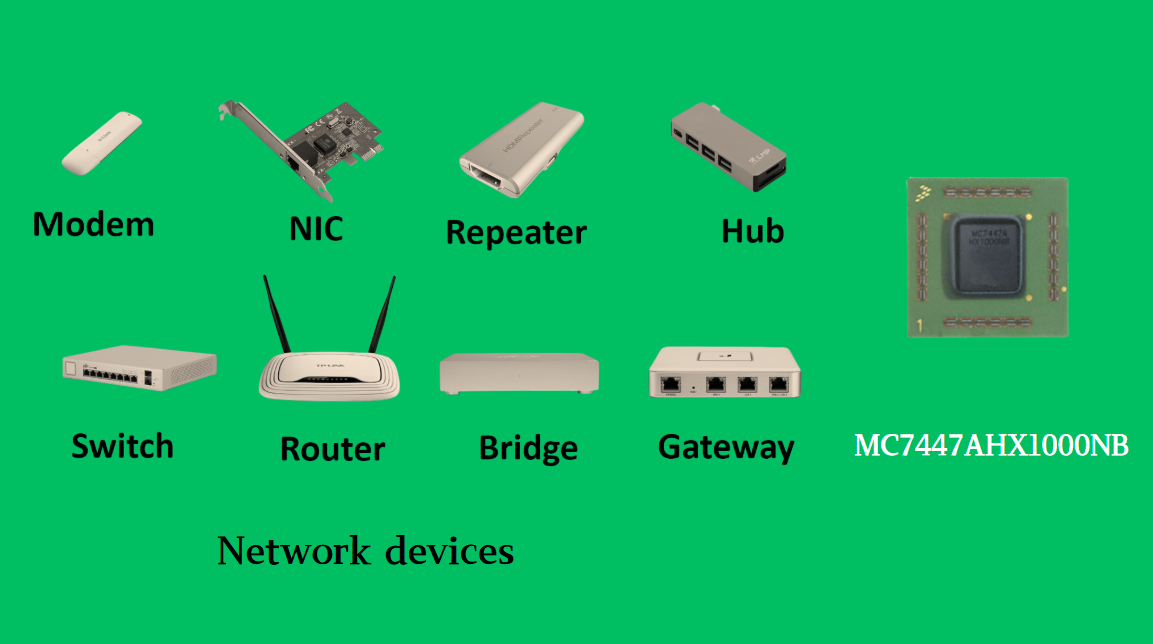
MC7447AHX1000NB Advantages and Disadvantages
Advantages
Powerful Parallel Processing Capability: Equipped with a superscalar architecture and 11 independent execution units (including integer, floating-point, vector, and load/store units), it supports multi-instruction parallel execution. With 4 instructions fetched per clock cycle and up to 16 instructions in the execution stage simultaneously, it significantly improves instruction throughput, making it suitable for high-load tasks such as data packet processing and real-time computing.
Efficient Cache System: The multi-level cache design (32KB L1 instruction + 32KB L1 data cache, 512KB L2 unified cache) with fast access speeds and low latency effectively reduces memory access bottlenecks. The MESI protocol ensures cache consistency in multi-processor systems, enhancing data synchronization efficiency.
Excellent Energy Efficiency Management: Integrates Dynamic Frequency Switching (DFS) and multiple low-power modes (Nap, Sleep, Deep Sleep), allowing flexible adjustment of power consumption based on load. The Deep Sleep mode can minimize standby power to 3.2W, meeting the low-power requirements of embedded systems.
Strong Compatibility and Scalability: Supports MPX and 60x bus protocols, with a 36-bit address bus and 64-bit data bus for efficient connection to memory and peripherals. It also supports multi-processor configurations, facilitating system expansion.
Reliable Stability Features: Built-in temperature diodes for real-time temperature monitoring, combined with voltage derating support, prevent performance degradation or damage due to overheating, ensuring stable operation in harsh environments.
Disadvantages
Relatively High Power Consumption Under Full Load: Although it has energy-saving mechanisms, its power consumption may be higher than that of some newer low-power architectures (such as ARM-based processors) when running at the maximum frequency of 1000MHz, which may limit its application in battery-powered devices with strict power constraints.
Older Architecture: As a product based on the PowerPC architecture, its ecosystem and software support are not as rich and updated as those of mainstream architectures like x86 or ARM. This may increase the difficulty and cost of software development and maintenance.
Limited Processing Power Compared to Modern Processors: With the advancement of semiconductor technology, modern processors (such as multi-core ARM Cortex-A series or Intel Xeon D) have higher core counts and more advanced microarchitectures, outperforming the MC7447AHX1000NB in terms of overall processing performance, especially in multi-threaded tasks.
Larger Package Size: The BGA package design, while ensuring high pin density, may require more complex PCB layout and manufacturing processes, increasing the difficulty of design for small-sized embedded devices.
MC7447AHX1000NB Alternatives
| Part Number | Manufacturer | Key Features | Use Case/Notes |
| MC7447AHX1333LB | NXP USA Inc. | 1.333GHz PowerPC G4 processor with SIMD support. Features 1.8V/2.5V I/O, 360-FCCBGA package, and operates up to 105°C. | High-performance embedded computing in industrial or network systems needing reliable speed and processing. |
| MC7410VU500LE | Freescale Semiconductor | 500MHz PowerPC G4 processor, 1.8V/2.5V/3.3V I/O, 360-CBGA package. No SIMD or co-processor support. | Suitable for lower-power or legacy applications needing PowerPC compatibility and broad I/O voltage range. |
| MC7410VU500LE | NXP USA Inc. | Same specs as above — 500MHz, no SIMD, supports wider I/O voltages. Comes in a 360-CBGA package, rated to 105°C. | Ideal for projects requiring a compatible replacement part or alternate vendor sourcing. |
MC7447AHX1000NB Category-PowerPC Architecture Processor
PowerPC Architecture Processors are RISC (Reduced Instruction Set Computing) microprocessors jointly developed by IBM, Apple, and Motorola in 1993. Characterized by high performance, low power consumption, and strong scalability, they adopt superscalar designs with multi-stage pipelines, supporting symmetric multiprocessing (SMP) for efficient parallel computing.
Key technical features include AltiVec vector processing technology (enhancing multimedia and signal processing), multi-level cache hierarchies (reducing memory latency), and flexible bus interfaces (adapting to diverse system architectures).
Widely used in embedded systems (industrial controllers, network routers), consumer electronics (early Apple Macs, game consoles like Xbox 360), and aerospace/defense fields, they excel in real-time performance and reliability. Though overshadowed by ARM in mobile markets, PowerPC remains vital in specialized domains requiring stable, long-lifecycle processing solutions.
MC7447AHX1000NB Manufacturer
The original manufacturer of the MC7447AHX1000NB is Freescale Semiconductor, and this product belongs to its classic MPC74xx series, developed based on the PowerPC G4 architecture. After Freescale was acquired by NXP Semiconductors in 2015, this series of products was inherited by NXP and continues to be supported, and is currently part of NXP's embedded processing product line.
As a technological pioneer deeply engaged in the embedded field, when designing the MC7447AHX1000NB, Freescale focused on balancing high performance and reliability: a 1GHz main frequency combined with a superscalar pipeline and 512KB L2 cache to meet the high throughput requirements of network devices; the 360-pin FCCBGA package (25x25mm) supports industrial-grade wide temperature ranges (with extended models covering -40~105℃), making it suitable for harsh environments. After taking over, NXP has continued the long-term maintenance of this series, ensuring the continuous supply of the product in industrial control, edge computing and other scenarios through official website chemical compliance statements (such as RoHS, ELV) and original factory stock channels (such as Shenzhen Huaxiong Semiconductor and other agents).
It is worth noting that the pin-compatible design of the MC7447AHX1000NB (which can directly replace the MPC7447) reflects Freescale's consideration of customers' migration costs, and NXP's global supply chain (such as warehouses in the United States and Hong Kong, China) has further consolidated its market position. Although the ARM architecture has gradually become popular, this processor still maintains competitiveness in niche fields with strict requirements for real-time performance and compatibility, relying on the stability of the PowerPC ecosystem.
As a classic product of NXP's PowerPC architecture, the MC7447AHX1000NB achieves a perfect balance between performance and reliability at a frequency of 1000MHz by integrating technologies such as superscalar design, multi-level cache, and dynamic energy efficiency control. Its pin compatibility and rich functional features not only provide a convenient path for upgrading existing systems but also bring flexible choices for new designs. In the fields of network and embedded computing, this processor is undoubtedly an ideal solution that takes into account performance, cost, and stability.
Hot-selling products of SIC
71421LA55J8 UPD44165184BF5-E40-EQ3-A SST39VF800A-70-4C-B3KE IS66WV1M16DBLL-55BLI-TR AS4C32M16SB-7BIN W25Q16FWSNIG
AS7C34098A-20JIN 752369-581-C W957D6HBCX7I TR IS61LPS12836EC-200B3LI MX25L12875FMI-10G QG82915PL
Product information is from SIC Electronics Limited. If you are interested in the product or need product parameters, you can contact us online at any time or send us an email: sales@sic-chip.com.
MC7447AHX1000NB Frequently Asked Questions [FAQ]
1. What is the MC7447AHX1000NB used for?
The MC7447AHX1000NB is used in embedded systems that need reliable performance, like multimedia devices, industrial controllers, and communication equipment. It handles data processing, audio/video tasks, and system management without needing too much power or space.
2. Does the MC7447AHX1000NB support debugging through JTAG?
Yes, it does. The chip includes a JTAG interface through the COP header, which allows you to connect a debugger for testing and troubleshooting. The setup includes connections for reset, clock, and data lines, making it easier to manage development and error checking.
3. Can the MC7447AHX1000NB run in harsh environments?
Yes, it operates in a wide temperature range from 0°C to 105°C. This makes it suitable for use in both indoor and outdoor environments, including industrial settings where temperatures can vary.
4. What voltage levels does the chip support?
It supports dual I/O voltages of 1.8V and 2.5V. This helps with compatibility when connecting it to different components on the board, so you can build a system without running into voltage mismatches.
5. Is the MC7447AHX1000NB easy to mount on a circuit board?
The chip comes in a surface-mount 360-ball FCCBGA package, which is commonly used in modern assembly. While it does require proper placement equipment, it fits well into standard build processes and is easy to integrate into compact board designs.





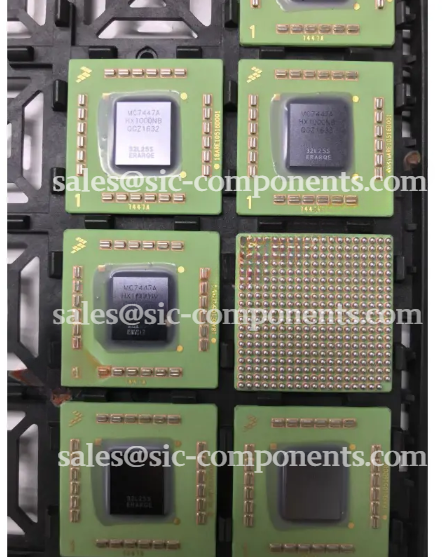




 Wishlist (0 Items)
Wishlist (0 Items) 